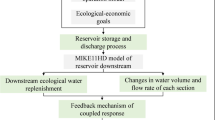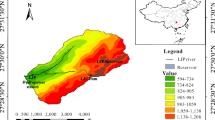Abstract
The ecological flow requirement (EFR) during special life stages of species, for instance the fish spawning period, concerns not only the flow rate, but also daily changes in the flow rate. Therefore, it is more appropriate to optimize ecologically-friendly reservoir operation on a daily base. Directly formulating and solving a daily-based optimization model would involve a large number of decision variables as well as constraints, which may lead to unfavourable time consumption and unreliable solutions. This study proposes a time-nested approach to derive an optimal daily reservoir operation scheme with consideration of the downstream ecological hydrograph. It scales down the decision variables from monthly-base to 10-day base and finally to daily-base. The proposed method was applied to two cascaded reservoirs in the Yalong River in southwest China, where a daily ecological flow is required to conserve the habitats of an indigenous fish Schizothorax chongi (S. chongi). The results showed that the developed method could efficiently derive a daily optimal operational scheme with the consideration of downstream EFR for fish habitat conservation. In addition, the method greatly improves global searching ability in dealing with complex optimization problems.






Similar content being viewed by others
References
Acreman M (2000) Managed flood releases from reservoirs: Issues and Guidance. Center for Ecology and Hydrology, UK. http://www.dams.org/docs/kbase/contrib/opt056.pdf. Accessed 13 Mar 2013
Ban X (2011) Ecological flow requirement for Chinese sturgeon spawning habitat. J Hydraul Eng 42(1):47–55 (in Chinese)
Bednarek AT, Hart DD (2005) Modifying dam operations to restore rivers: ecological responses to Tennessee River dam mitigation. Ecol Appl 15(3):997–1008
Cardwell H, Jager HI, Sale MJ (1996) Designing instream flows to satisfy fish and human water needs. J Water Res PL ASCE 122(5):356–363
Castro DM, Hughes RM, Callisto M (2013) Effects of flow fluctuations on the daily and seasonal drift of invertebrates in a tropical river. Ann Limnol-Int J Lim 49(03):169–177
Chang FJ, Chen L (1998) Real-coded genetic algorithm for rule based flood control reservoir management. Water Resour Manag 12(3):185–198
Chen Q, Chen D, Li R, Ma J, Blanckaert K (2013) Adapting the operation of two cascaded reservoirs for ecological flow requirement of a de-watered river channel due to diversion-type hydropower stations. Ecol Model 252:266–272
Croke BFW, Ticehurst JL, Letcher RA, Norton JP, Newham LTH, Jakeman AJ (2007) Integrated assessment of water resources: Australian experiences. Water Resour Manag 21(1):351–373
ECIDI–East China Investigation and Design Institute (2005) Report of environmental impact assessment on Jinping–II hydropower project. Hangzhou China (in Chinese)
Gandolfi C, Guariso G, Togni D (1997) Optimal flow allocation in the Zambezi River system. Water Resour Manag 11(5):377–393
Goldberg DE (1989) Genetic Algorithms in search, optimization and machine learning. Addison–Wesley Publishing Co Inc, Reading
Goulter IC, Castensson RG (1988) Screening model for assessing ‘cost’ of minimum flow requirements in the Svartå River. Sweden Water Resour Manag 2(1):35–55
Haas NA, O’Connor BL, Hayse JW, Bevelhimer MS, Endreny TA (2014) Analysis of daily peaking and run‐of‐river operations with flow variability metrics, considering subdaily to seasonal time scales. J Am Water Resour As 50(6):1622–1640
Hakimi–Asiabar M, Ghodsypour SH, Kerachian R (2010) Deriving operating policies for multi–objective reservoir systems: application of self–learning genetic algorithm. Appl Soft Comput 10(4):1151–1153
Harman C, Stewardson M (2005) Optimizing dam release rules to meet environmental flow targets. River Res Appl 21(2–3):113–129
Homa ES, Vogel RM, Smith MP, Apse CD, Huber–Lee A, Sieber J (2005) An optimization approach for balancing human and ecological flow needs. In: EWRI 2005:Impacts of Global Climate Change, Proceedings of the 2005 World Water and Environmental Resources Congress Anchorage, Alaska
Hu B, Cui B, Dong S, Zhai H, Liu Z (2009) Ecological water requirement (EWR) analysis of High Mountain and Steep Gorge (HMSG) river-application to Upper Lancang–Mekong river. Water Resour Manag 23(2):341–366
Jager HI, Rose KA (2003) Designing optimal flow patterns for fall chinook salmon in a Central Valley river. N Am J Fish Manag 23:1–21
Jones NE (2014) The dual nature of hydropeaking rivers: is ecopeaking possible? River Res Appl 30(4):521–526
Labadie JW (2004) Optimal operation of multi reservoir systems: state–of–the–art review. J Water Res PL–ASCE 130(93):93–111
Li R, Chen Q, Chen D (2011) Ecological hydrograph based on Schiozothoraxchongi habitat conservation in the dewatered river channel between Jinping cascaded dams. Sci China Technol Sci 54(1):54–63
Oliveira R, Loucks D (1997) Operating rules for multi reservoir systems. Water Resour Res 33(4):839–852
Poff NL, Allan JD, Bain MB, Karr JR, Prestegaard KL, Richter BD, Sparks R, Stromberg J (1997) The natural flow regime: a new paradigm for riverine conservation and restoration. Bio Sci 47:769–784
Richter BD, Baumgartner JV, Powell J, Braun DP (1996) A method for assessing hydrologic alteration within ecosystems. Conserv Biol 10:1163–1174
Richter BD, Baumgartner JV, Wigington R, Braun DP (1997) How much water does a river need? Freshw Biol 37:231–249
Sale MJ, Brill ED, Herrick EE (1982) An approach to optimizing reservoir operation for downstream aquatic resources. Water Resour Res 18(4):705–712
Schaffer JD (1984) Some experiments in machine learning using vector evaluated genetic algorithms Ph.D. thesis Vanderbilt University Nashville TN
Shiau JT, Wu FC (2006) Compromise programming methodology for determining in stream flow under multiobjective water allocation criteria. J Am Water Resour As 42(5):1179–1191
Smith BT, Jager HI, Sale, MJ (2007) Optimization of hydropower resources: current practices and opportunities for improvement. ORNL/TM–2006/91 Oak Ridge National Laboratory
Suen JP, Eheart JW (2006) Reservoir management to balance ecosystem and human needs: incorporating the paradigm of the ecological flow regime. Water Resour Res 42, W03417
Suen JP, Eheart JW, Herricks EE, Chang FJ (2009) Evaluating the potential impact of reservoir operation on fish communities. J Water Res PL–ASCE 135(6):475–483
U.S. Bureau of Reclamation (USBR) and U.S. Department of the Interior (USDOI) (1996) An Assessment of the Environmental Impact Statement on the Operations of the Gland Canyon Dam. U.S. General Accounting Office Report to Congressional Committees
Wurbs RA (1993) Reservoir–System simulation and optimization models. J Water Res PL–ASCE 119(4):455–472
Xia X, Yang Z, Wu Y (2009) Incorporating eco-environmental water requirements in integrated evaluation of water quality and quantity—a study for the Yellow River. Water Resour Manag 23(6):1067–1079
Yang Z, Sun T, Cui B, Chen B, Chen G (2009) Environmental flow requirements for integrated water resources allocation in the Yellow River Basin China. Commun Nonlinear Sci 114(5):2469–2481
Yeh W (1985) Reservoir management and operation models: a state-of-the-art review. Water Resour Res 121:1797–1818
Acknowledgments
This work is supported by National Natural Science Foundation of China (No. 51425902, No. 51109012, No. 51279196).
Author information
Authors and Affiliations
Corresponding author
Rights and permissions
About this article
Cite this article
Chen, D., Li, R., Chen, Q. et al. Deriving Optimal Daily Reservoir Operation Scheme with Consideration of Downstream Ecological Hydrograph Through A Time-Nested Approach. Water Resour Manage 29, 3371–3386 (2015). https://doi.org/10.1007/s11269-015-1005-z
Received:
Accepted:
Published:
Issue Date:
DOI: https://doi.org/10.1007/s11269-015-1005-z




